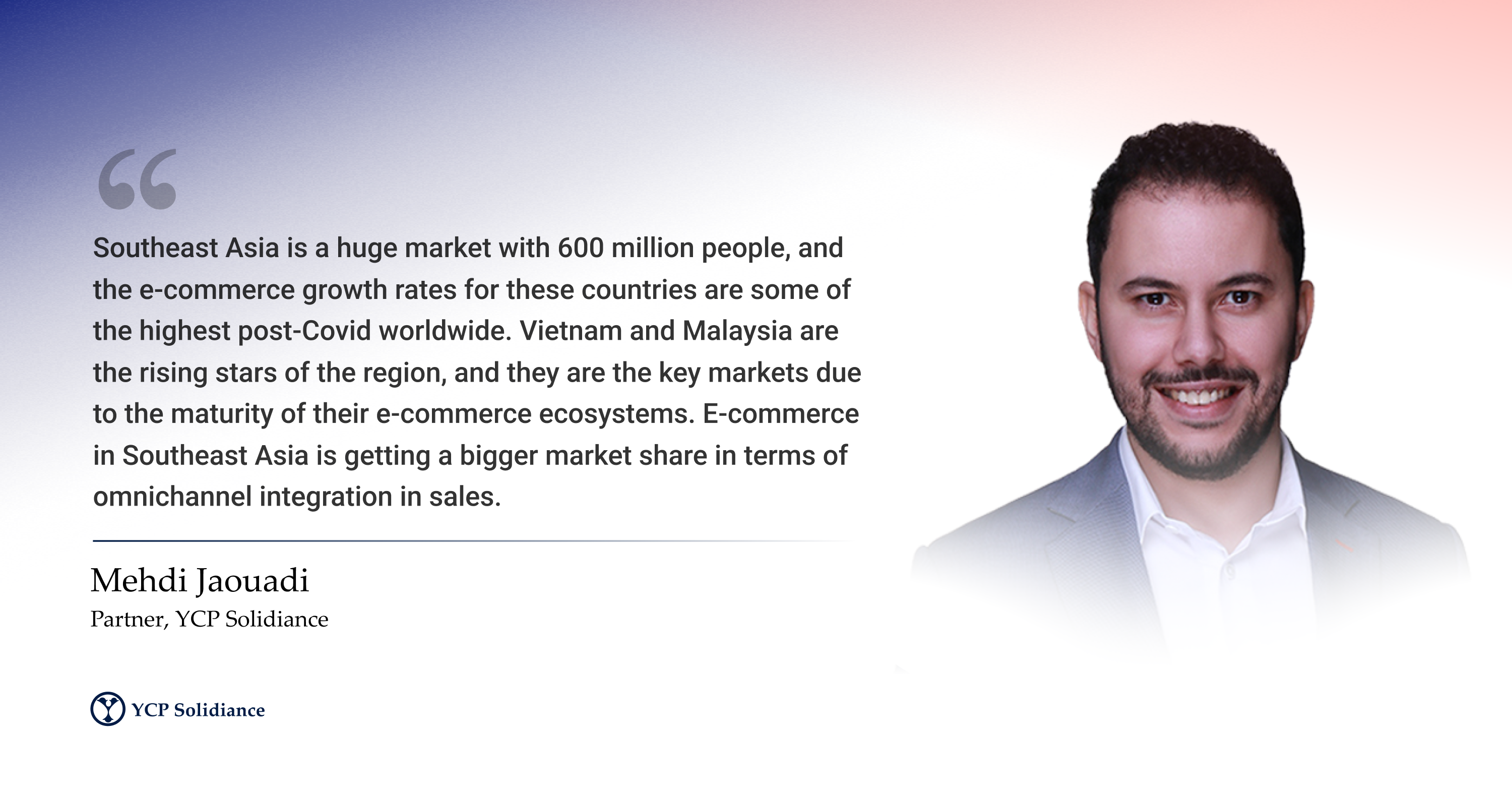Author
Mehdi Jaouadi
Mehdi is a Partner based in Thailand, with over 14 years of experience in strategy formulation, business development, and large-scale expansion growth within Automotive, FMCG, Healthcare, and other sectors.
E-commerce is one of Southeast Asia's fastest-growing and most dynamic sectors, a region with over 660 million people and a combined GDP of almost 4 trillion US dollars. Despite the challenges posed by the COVID-19 pandemic, e-commerce has shown remarkable resilience and innovation as more consumers and merchants shifted online to meet their needs and preferences. According to industry reports, e-commerce in the region is projected to reach a market value of 211 billion US dollars by 2025, growing at a compound annual growth rate of 22%.
Our Partner, Mehdi Jaouadi, shared his expert insight on the rapidly evolving e-commerce landscape in the region at the exclusive webinar, "Unveiling E-commerce Opportunities in Southeast Asia," presented by Santander UK with YCP Solidiance, Lazada, and Synagie Group.
The Post-Covid E-commerce Landscape
Southeast Asia is a huge market for e-commerce, with a population of over 600 million people and a combined GDP of 3 trillion US dollars. The region has the highest growth rate in GDP post-Covid, with an average of 6.2% in 2021 and 5.1% in 2022. This reflects the resilience and recovery of the Southeast Asian economies, as well as the increasing digitalization and innovation in various sectors, especially e-commerce.
Among the Southeast Asian countries, Singapore has the lowest population size but the highest GDP per capita, at 82,807 USD in 2022. Singapore is also a leader in e-commerce, with a penetration rate of 30% and a market size of 9 billion US dollars in 2021. Singapore’s e-commerce market is driven by its high internet and smartphone penetration, affluent and tech-savvy consumers, advanced logistics and payment infrastructure, and supportive government policies.
The Southeast Asian e-commerce market is experiencing robust growth, with a compounded annual growth rate (CAGR) of 11.4% in five years. E-commerce in the region grew fourfold from 2017 to 2021, reaching 20% of all retail sales. The COVID-19 pandemic accelerated the shift to online shopping, as consumers adapted to the new normal and demanded a more comprehensive range of products to be available online.
The e-commerce market in Southeast Asia is dominated by electronics, which accounts for 34% of the market share, followed by beauty, personal care, and health, which accounts for 16%, and fashion, which accounts for 15%. These categories are growing fast and gaining traction, as more consumers seek convenience, quality, variety, and value for money.
The Region’s Emerging E-commerce Markets
Myanmar and Malaysia show high potential for e-commerce growth, with a CAGR of 13% each in 2021. Despite political instability marring the country, Myanmar shows great potential in the e-commerce industry, given its young and tech-savvy population.
Malaysia also has a mature e-commerce ecosystem and high consumer spending power from a sophisticated and knowledgeable consumer base. The e-commerce market in Malaysia is dominated by online marketplaces such as Shopee, Lazada, and Zalora, which offer a wide range of products and services across various categories such as beauty and personal care, consumer electronics, fashion and apparel, food and beverage, and furniture and home.
Vietnam is another country with a mature e-commerce ecosystem and a large and dynamic online consumer base. It is one of the fastest-growing internet economies, dominated by online marketplaces like Shopee, Lazada, and Zalora. The country’s e-commerce market is expected to reach USD 15 billion by 2025.
Future Trends in E-commerce
One of the future trends in e-commerce is omnichannel e-commerce, which aims to provide seamless customer experiences across diverse channels, such as online platforms, mobile apps, social media, and physical stores. This can help improve customer engagement and retention, as well as increase sales and brand loyalty.
Another trend is AI integration, which can help enhance customer service, streamline operations, and boost profits. AI can also offer valuable customer insights, targeted marketing, optimized pricing, better customer support, and fraud prevention.
Moreover, on-demand and last-mile delivery is a significant transformation in the logistics landscape, as it can address the logistical challenges of e-commerce, such as speed, convenience, reliability, and cost.
The B2B2C fulfillment model is another trend that can increase cross-border transactions and harness collaboration between other players in the e-commerce ecosystem, such as manufacturers, wholesalers, retailers, and consumers. This can help leverage tax benefits, faster delivery, and greater efficiency.






